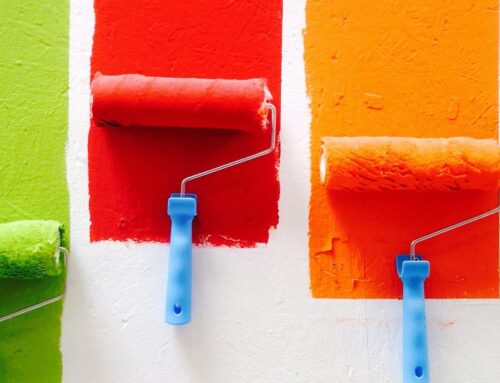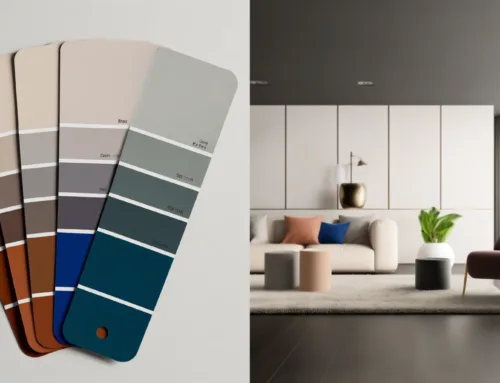
Painting is a great way to refresh and update the look of your home or business. Whether you’re tackling a small DIY project or a large-scale renovation, having the right tools and equipment is crucial to achieving a professional-looking finish. Without the proper tools, you may end up with uneven paint coverage, streaks, or other imperfections that can detract from the overall appearance of your space. In this blog post, we will discuss the different types of painting tools and equipment and how to choose the right ones for your project.
Key Takeaways
- Having the right painting tools and equipment is crucial for a successful painting project.
- Understanding the different types and sizes of brushes can help achieve the desired finish.
- Choosing the right roller for the job can save time and effort.
- Paint sprayers have pros and cons and should be used with caution.
- Protecting floors and furniture with drop cloths and tarps is important to avoid damage.
Brushes: Understanding the Different Types and Sizes
Brushes are one of the most basic and essential painting tools. They come in different types and sizes, each designed for specific painting tasks. Natural bristle brushes are best for oil-based paints, while synthetic brushes are ideal for water-based paints. Natural bristle brushes have split ends that hold more paint and provide a smoother finish, making them perfect for oil-based paints. Synthetic brushes, on the other hand, are made from nylon or polyester bristles and are better suited for water-based paints because they don’t absorb as much water.
The size of the brush should also match the size of the area being painted. For smaller areas or detailed work, use a smaller brush with a narrow tip. This will allow for more precision and control. For larger areas, use a larger brush with a wider tip to cover more surface area in less time. It’s important to note that using a brush that is too small for a large area can result in visible brush strokes and an uneven finish.
Rollers: Choosing the Right Roller for the Job
Rollers are great for painting large areas quickly and efficiently. They consist of a handle and a roller cover that is attached to it. The roller cover is made of fabric or foam and has a nap, or thickness, that determines the texture of the paint finish. The nap should be chosen based on the texture of the surface being painted.
For smooth surfaces, such as walls or ceilings, a short nap roller is best. Short nap rollers have a nap length of 3/16 to 1/4 inch and provide a smooth, even finish. They are also easier to clean and maintain. For textured surfaces, such as stucco or brick, a long nap roller is ideal. Long nap rollers have a nap length of 3/8 to 1 inch and can reach into the crevices and uneven areas of textured surfaces, ensuring full coverage.
Paint Sprayers: Pros and Cons of Using a Paint Sprayer
| Pros | Cons |
|---|---|
| Efficiency: Paint sprayers can cover large areas quickly and evenly, saving time and effort. | Cost: Paint sprayers can be expensive to purchase or rent, and may require additional equipment such as an air compressor. |
| Professional finish: Paint sprayers can produce a smooth, professional-looking finish with no brush or roller marks. | Overspray: Paint sprayers can create a fine mist of paint that can settle on nearby surfaces, requiring careful masking and preparation. |
| Versatility: Paint sprayers can be used on a variety of surfaces, including walls, ceilings, furniture, and cabinets. | Cleanup: Paint sprayers require thorough cleaning after each use, which can be time-consuming and messy. |
| Speed: Paint sprayers can complete large projects in a fraction of the time it would take to paint by hand. | Experience: Paint sprayers require some skill and experience to use effectively, and may not be suitable for beginners. |
Paint sprayers are a fast and efficient way to paint large areas. They use compressed air or high-pressure pumps to atomize the paint into tiny droplets that are then sprayed onto the surface. This allows for quick and even coverage, especially on large, flat surfaces like walls or fences.
However, paint sprayers can be messy and require more preparation and cleanup than other painting methods. They can create overspray, which is fine particles of paint that can drift onto nearby surfaces. This can be mitigated by using drop cloths and masking off areas that you don’t want to be painted. Additionally, paint sprayers require more skill and practice to use effectively. It’s important to maintain a consistent distance from the surface being painted and to apply the paint in even strokes to avoid streaks or drips.
Paint sprayers are best suited for large, open areas with minimal furniture or decor. They are not recommended for small or intricate spaces where precision is required. If you’re unsure about using a paint sprayer, it may be best to stick with brushes or rollers for your painting project.
Drop Cloths and Tarps: Protecting Your Floors and Furniture
Drop cloths and tarps are essential for protecting your floors and furniture from paint splatters and spills. They create a barrier between the painted surface and the surrounding area, preventing any accidental damage. There are different types of drop cloths and tarps available, each with its own advantages.
Plastic drop cloths are best for protecting floors. They are lightweight, waterproof, and easy to clean up. However, they can be slippery, so it’s important to secure them in place with tape or weights to prevent accidents. Plastic drop cloths are also not suitable for protecting furniture or other delicate items, as they can trap moisture and cause damage.
Canvas drop cloths, on the other hand, are ideal for protecting furniture and other delicate items. They are made from heavy-duty fabric that is absorbent and durable. Canvas drop cloths are less likely to slip or move around, providing better protection for your belongings. They can also be reused multiple times, making them a more sustainable option.
Sandpaper and Sanding Tools: Preparing Surfaces for Painting

Before you start painting, it’s important to prepare the surfaces by sanding them. Sandpaper and sanding tools are used to smooth out rough surfaces, remove old paint or varnish, and create a clean and even surface for the paint to adhere to.
Sandpaper comes in different grits, which refers to the coarseness of the abrasive particles on the paper. The grit of the sandpaper should be chosen based on the texture of the surface being sanded. For rough surfaces or heavy-duty sanding, use a lower grit sandpaper, such as 60 or 80 grit. This will remove more material and create a smoother surface. For lighter sanding or finishing work, use a higher grit sandpaper, such as 120 or 220 grit. This will provide a finer finish without removing too much material.
In addition to sandpaper, there are also sanding tools available that can make the sanding process easier and more efficient. Sanding blocks or sponges are handheld tools that have sandpaper attached to them. They provide a firm grip and allow for more control and precision when sanding. Electric sanders, such as orbital sanders or detail sanders, are powered tools that use a rotating disc or pad to sand surfaces quickly and evenly. These tools are especially useful for larger projects or when working with large, flat surfaces.
Painting Accessories: Tape, Trays, and More
In addition to brushes, rollers, and sprayers, there are several painting accessories that can help make your painting project easier and more efficient. These accessories can help you achieve clean lines, prevent drips and spills, and protect areas that you don’t want to be painted.
Painter’s tape is one of the most commonly used painting accessories. It is a type of masking tape that is specifically designed for painting. Painter’s tape has a special adhesive that allows it to be easily removed without damaging the surface or leaving behind any residue. It is great for creating clean lines and protecting areas from paint. Use painter’s tape to mask off trim, windows, or any other areas that you don’t want to be painted.
Paint trays are another essential painting accessory. They are shallow containers that hold the paint and allow you to dip your brush or roller into it. Paint trays come in different sizes and materials, such as plastic or metal. Choose a paint tray that is large enough to hold an adequate amount of paint for your project. Look for trays with ridges or grooves on the bottom, as these can help remove excess paint from your brush or roller.
Edgers are tools that help you achieve clean lines along edges or corners. They have a flat surface with a guide wheel or pad that allows you to glide along the edge while applying paint. Edgers are especially useful for painting around trim, baseboards, or other areas where a straight line is required. They can save you time and effort by eliminating the need for tedious and time-consuming brushwork.
Ladders and Scaffolding: Reaching High Places Safely
When painting high places such as ceilings or tall walls, ladders and scaffolding are necessary to reach those areas safely. It’s important to choose the right ladder or scaffold for the job and to use them safely to prevent accidents or injuries.
Ladders come in different types and sizes, each designed for specific tasks. Step ladders are self-supporting and have a hinged design that allows them to be folded for easy storage. They are great for painting walls or ceilings because they provide a stable platform to work from. Extension ladders, on the other hand, are adjustable in length and can be leaned against a wall or other surface for support. They are ideal for reaching higher areas, such as second-story windows or tall walls.
When using a ladder, make sure it is on a stable and level surface. Lock the ladder in place and use the appropriate safety precautions, such as wearing non-slip shoes and using a ladder stabilizer or standoff to prevent the ladder from damaging the surface being painted. It’s also important to never stand on the top rung of the ladder or overreach while painting.
Scaffolding is another option for reaching high places safely. It consists of a platform that is supported by metal poles or frames. Scaffolding provides a larger working area and can be adjusted to different heights. It is more stable than ladders and allows for easier movement around the work area. However, scaffolding can be more expensive and time-consuming to set up compared to ladders.
Champion Painting: The Benefits of Working with a Professional Painting Company
 While DIY painting projects can be fun and rewarding, there are times when it’s best to leave the job to the professionals. Working with a professional painting company like Champion Painting can save you time and ensure a high-quality finish.
While DIY painting projects can be fun and rewarding, there are times when it’s best to leave the job to the professionals. Working with a professional painting company like Champion Painting can save you time and ensure a high-quality finish.
Professional home painters near me have the experience and expertise to handle any painting project, big or small. They have the knowledge of different paint types and finishes, as well as the skills to properly prepare surfaces, apply paint evenly, and create clean lines. Professional painters also have access to high-quality tools and equipment that may not be readily available to homeowners.
In addition to their technical skills, professional painters can also provide valuable advice and guidance throughout the painting process. They can help you choose the right colors and finishes for your space, as well as offer tips on maintenance and care to ensure the longevity of your paint job.
Investing in Quality Tools and Equipment for a Successful Painting Project
Investing in quality painting tools and equipment is essential for achieving a professional-looking finish. By understanding the different types of tools and equipment and choosing the right ones for your project, you can ensure a successful painting project. Brushes, rollers, paint sprayers, drop cloths, sandpaper, and other accessories all play a role in creating a smooth and even paint finish. Additionally, using ladders or scaffolding can help you reach high places safely. If you’re unsure about tackling a painting project on your own, consider working with a professional painting company like Champion Painting to save time and achieve a high-quality finish.
If you’re looking to enhance your painting project with some stylish and functional storage solutions, you’ll definitely want to check out this article on the best floating shelves. These shelves not only provide a convenient place to store your painting tools and equipment, but they also add a touch of elegance to any room. Whether you’re revamping your home office or simply looking for ways to declutter your space, these floating shelves are a must-have. Don’t miss out on this opportunity to elevate your painting experience! Read more
Take a look at the cities we have to offer
- House painters in Nipomo,
- House painters in Santa Maria,
- House painters in San Luis Obispo,
- House painters in Grover Beach,
- House painters in Shell Beach,
- House painters in Oceano,
FAQs

What are painting tools and equipment?
Painting tools and equipment are the tools and materials used in the process of painting. These include brushes, rollers, paint sprayers, paint trays, drop cloths, sandpaper, and other related items.
What are the different types of painting tools?
There are several types of painting tools, including brushes, rollers, paint sprayers, paint trays, drop cloths, sandpaper, and masking tape. Each tool has a specific purpose and is used for different types of painting projects.
What are the different types of paint brushes?
There are several types of paint brushes, including flat brushes, angled brushes, round brushes, and fan brushes. Each brush is designed for a specific purpose and is used for different types of painting projects.
What are the different types of paint rollers?
There are several types of paint rollers, including foam rollers, nap rollers, and microfiber rollers. Each roller is designed for a specific purpose and is used for different types of painting projects.
What are the different types of paint sprayers?
There are several types of paint sprayers, including airless sprayers, HVLP sprayers, and compressed air sprayers. Each sprayer is designed for a specific purpose and is used for different types of painting projects.
What are the different types of paint trays?
There are several types of paint trays, including disposable trays, metal trays, and plastic trays. Each tray is designed for a specific purpose and is used for different types of painting projects.
What are the different types of drop cloths?
There are several types of drop cloths, including canvas drop cloths, plastic drop cloths, and paper drop cloths. Each drop cloth is designed for a specific purpose and is used for different types of painting projects.
What are the different types of sandpaper?
There are several types of sandpaper, including coarse sandpaper, medium sandpaper, and fine sandpaper. Each type of sandpaper is used for different types of painting projects, such as sanding down rough surfaces or smoothing out surfaces before painting.
What is masking tape used for in painting?
Masking tape is used to protect surfaces that should not be painted, such as trim, windows, and door frames. It is applied to the surface before painting and removed after the paint has dried.
Page Design by; Web Design Near Me

Champion Painting
Recent Post's
Painting cost estimate is an important consideration for anyone embarking on a painting project. Whether you are looking to freshen up the interior of your
Painting is a great way to refresh and update the look of your home or business. Whether you're tackling a small DIY project or a
Professional house painting services can greatly benefit homeowners by saving them time and effort while achieving a high-quality finish. Painting a house can be a
Earthy neutrals are a popular choice in home design due to their warm and inviting nature. These colors, which include shades of brown, beige, and
Get a Free Estimate
















